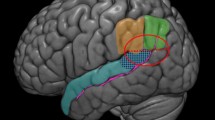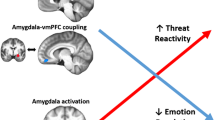Abstract
The goal of this article is to provide a selective and targeted review of the neuroimaging literature on psychopathic tendencies and antisocial behavior and to explore the extent to which this literature supports recent cognitive neuroscientific models of psychopathy and antisocial behavior. The literature reveals that individuals who present with an increased risk for reactive, but not instrumental, aggression show increased amygdala responses to emotionally evocative stimuli. This is consistent with suggestions that such individuals are primed to respond strongly to an inappropriate extent to threatening or frustrating events. In contrast, individuals with psychopathic tendencies show decreased amygdala and orbitofrontal cortex responses to emotionally provocative stimuli or during emotional learning paradigms. This is consistent with suggestions that such individuals face difficulties with basic forms of emotional learning and decision making.
Similar content being viewed by others
References
Papers of particular interest, published recently, have been highlighted as: •• Of major importance
Frick PJ: Callous-unemotional traits and conduct problems: a two-factor model of psychopathy in children. Issues Criminol Leg Psychol 1995, 24:47–51.
Hare RD: Hare Psychopathy Checklist-Revised, edn 2. Toronto: Multi-Health Systems; 2003.
Lynam DR, Caspi A, Moffitt TE, et al.: Longitudinal evidence that psychopathy scores in early adolescence predict adult psychopathy. J Abnorm Psychol 2007, 116:155–165.
Blair RJR: A cognitive developmental approach to morality: investigating the psychopath. Cognition 1995, 57:1–29.
•• Blair RJR: The amygdala and ventromedial prefrontal cortex in morality and psychopathy. Trends Cogn Sci 2007, 11:387–392. This article provides considerably more detail on the theoretical position underpinning the current article.
Gordon HL, Baird AA, End A: Functional differences among those high and low on a trait measure of psychopathy. Biol Psychiatry 2004, 56:516–521.
Rilling JK, Glenn AL, Jairam MR, et al.: Neural correlates of social cooperation and non-cooperation as a function of psychopathy. Biol Psychiatry 2007, 61:1260–1271.
Yang Y, Raine A, Colletti P, et al.: Abnormal temporal and prefrontal cortical gray matter thinning in psychopaths. Mol Psychiatry 2009, 14:561–562.
Kiehl KA, Smith AM, Hare RD, et al.: Limbic abnormalities in affective processing by criminal psychopaths as revealed by functional magnetic resonance imaging. Biol Psychiatry 2001, 50:677–684.
Finger EC, Marsh AA, Mitchell DG, et al.: Abnormal ventromedial prefrontal cortex function in children with psychopathic traits during reversal learning. Arch Gen Psychiatry 2008, 65:586–594.
Dolan MC, Fullam RS: Psychopathy and functional magnetic resonance imaging blood oxygenation level-dependent responses to emotional faces in violent patients with schizophrenia. Biol Psychiatry 2009, 66:570–577.
Rubia K, Halari R, Smith AB, et al.: Shared and disorder-specific prefrontal abnormalities in boys with pure attention-deficit/hyperactivity disorder compared to boys with pure CD during interference inhibition and attention allocation. J Child Psychol Psychiatry 2009, 50:669–678.
Sterzer P, Stadler C, Poutska F, Kleinschmidt A: A structural neural deficit in adolescents with conduct disorder and its association with lack of empathy. Neuroimage 2007, 37:335–342.
•• Lee TM, Chan SC, Raine A: Strong limbic and weak frontal activation to aggressive stimuli in spouse abusers. Mol Psychiatry 2008, 13:655–656. This article provides an excellent description of the predominantly reactive nature of the aggression of spouse abusers and demonstrates their increased amygdala responsiveness to emotionally provocative stimuli.
Coccaro EF, McCloskey MS, Fitzgerald DA, Phan KL: Amygdala and orbitofrontal reactivity to social threat in individuals with impulsive aggression. Biol Psychiatry 2007, 62:168–178.
New AS, Hazlett EA, Newmark RE, et al.: Laboratory induced aggression: a positron emission tomography study of aggressive individuals with borderline personality disorder. Biol Psychiatry 2009, 66:1107–1114.
Crick NR, Dodge KA: Social information-processing mechanisms on reactive and proactive aggression. Child Dev 1996, 67:993–1002.
Cornell DG, Warren J, Hawk G, et al.: Psychopathy in instrumental and reactive violent offenders. J Consult Clin Psychol 1996, 64:783–790.
Blanchard RJ, Blanchard DC, Takahashi LK: Attack and defensive behaviour in the albino rat. Anim Behav 1977, 25:197–224.
Gregg TR, Siegel A: Brain structures and neurotransmitters regulating aggression in cats: implications for human aggression. Prog Neuropsychopharmacol Biol Psychiatry 2001, 25:91–140.
Blair KS, Smith BW, Mitchell DG, et al.: Modulation of emotion by cognition and cognition by emotion. Neuroimage 2007, 35:430–440.
Ochsner KN, Gross JJ: The cognitive control of emotion. Trends Cogn Sci 2005, 9:242–249.
Urry HL, van Reekum CM, Johnstone T, et al.: Amygdala and ventromedial prefrontal cortex are inversely coupled during regulation of negative affect and predict the diurnal pattern of cortisol secretion among older adults. J Neurosci 2006, 26:4415–4425.
Lee TM, Chan SC, Raine A: Hyperresponsivity to threat stimuli in domestic violence offenders: a functional magnetic resonance imaging study. J Clin Psychiatry 2009, 70:36–45.
Herpertz SC, Dietrich TM, Wenning B, et al.: Evidence of abnormal amygdala functioning in borderline personality disorder: a functional MRI study. Biol Psychiatry 2001, 50:292–298.
Koenigsberg HW, Siever LJ, Lee H, et al.: Neural correlates of emotion processing in borderline personality disorder. Psychiatry Res 2009, 172:192–199.
Minzenberg MJ, Fan J, New AS, et al.: Fronto-limbic dysfunction in response to facial emotion in borderline personality disorder: an event-related fMRI study. Psychiatry Res 2007, 155:231–243.
Donegan NH, Snaislow CA, Blumberg HP, et al.: Amygdala hyperreactivity in borderline personality disorder: implications for emotional dysregulation. Biol Psychiatry 2003, 54:1284–1293.
New AS, Hazlett EA, Buchsbaum MS, et al.: Blunted prefrontal cortical 18fluorodeoxyglucose positron emission tomography response to meta-chlorophenylpiperazine in impulsive aggression. Arch Gen Psychiatry 2002, 59:621–629.
Soloff PH, Meltzer CC, Greer PJ, et al.: A fenfluramine-activated FDG-PET study of borderline personality disorder. Biol Psychiatry 2000, 47:540–547.
Yang Y, Raine A, Narr KL, et al.: Localization of deformations within the amygdala in individuals with psychopathy. Arch Gen Psychiatry 2009, 66:986–994.
Raine A, Ishikawa SS, Arce E, et al.: Hippocampal structural asymmetry in unsuccessful psychopaths. Biol Psychiatry 2004, 55:185–191.
Laakso MP, Vaurio O, Koivisto E, et al.: Psychopathy and the posterior hippocampus. Behav Brain Res 2001, 118:187–193.
Raine A, Lencz T, Taylor K, et al.: Corpus callosum abnormalities in psychopathic antisocial individuals. Arch Gen Psychiatry 2003, 60:1134–1142.
Glenn AL, Raine A, Yaralian PS, Yang Y: Increased volume of the striatum in psychopathic individuals. Biol Psychiatry 2009 Aug 14 (Epub ahead of print).
O’Doherty J, Dayan P, Schultz J, et al.: Dissociable roles of ventral and dorsal striatum in instrumental conditioning. Science 2004, 304:452–454.
•• De Brito SA, Mechelli A, Wilke M, et al.: Size matters: increased grey matter in boys with conduct problems and callous-unemotional traits. Brain 2009, 132:843–852. This was a very provocative voxel-based morphometry-based study of boys with conduct problems and CU traits.
Good CD, Johnsrude IS, Ashburner J, et al.: A voxel-based morphometric study of ageing in 465 normal adult human brains. Neuroimage 2001, 14:21–36.
Tiihonen J, Rossi R, Laakso MP, et al.: Brain anatomy of persistent violent offenders: more rather than less. Psychiatry Res 2008, 163:201–212.
de Oliveira-Souza R, Hare RD, Bramati IE, et al.: Psychopathy as a disorder of the moral brain: fronto-temporo-limbic grey matter reductions demonstrated by voxel-based morphometry. Neuroimage 2008, 40:1202–1213.
Müller JL, Gänssbauer S, Sommer M, et al.: Gray matter changes in right temporal gyrus in criminal psychopaths. Evidence from voxel-based morphometry. Psychiatry Res 2008, 163:213–222.
Marsh AA, Finger EC, Mitchell DG, et al.: Reduced amygdala response to fearful expressions in children and adolescents with callous-unemotional traits and disruptive behavior disorders. Am J Psychiatry 2008, 165:712–720. (Published erratum appears in Am J Psychiatry 2008, 165:920; Am J Psychiatry 2008, 165:652.)
Jones AP, Laurens KR, Herba CM, et al.: Amygdala hypoactivity to fearful faces in boys with conduct problems and callous-unemotional traits. Am J Psychiatry 2009, 166:95–102.
Deeley Q, Daly E, Surguladze S, et al.: Facial emotion processing in criminal psychopathy. Preliminary functional magnetic resonance imaging study. Br J Psychiatry 2006, 189:533–539.
Müller JL, Sommer M, Wagner V, et al.: Abnormalities in emotion processing within cortical and subcortical regions in criminal psychopaths: evidence from a functional magnetic resonance imaging study using pictures with emotional content. Biol Psychiatry 2003, 54:152–162.
Birbaumer N, Veit R, Lotze M, et al.: Deficient fear conditioning in psychopathy: a functional magnetic resonance imaging study. Arch Gen Psychiatry 2005, 62:799–805.
Glenn AL, Raine A, Schug RA: The neural correlates of moral decision-making in psychopathy. Mol Psychiatry 2009, 14:5–6.
Murphy FC, Nimmo-Smith I, Lawrence AD: Functional neuroanatomy of emotions: a meta-analysis. Cogn Affect Behav Neurosci 2003, 3:207–233.
Izquierdo A, Murray EA: Selective bilateral amygdala lesions in rhesus monkeys fail to disrupt object reversal learning. J Neurosci 2007, 27:1054–1062.
Price JL: Comparative aspects of amygdala connectivity. Ann Rev N Y Acad Sci 2003, 985:50–58.
Budhani S, Marsh AA, Pine DS, Blair RJ: Neural correlates of response reversal: considering acquisition. Neuroimage 2007, 34:1754–1765.
Kiehl KA: A cognitive neuroscience perspective on psychopathy: evidence for paralimbic system dysfunction. Psychiatry Res 2006, 142:107–128.
Rolls ET: The orbitofrontal cortex. Philos Trans R Soc Lond B Biol Sci 1997, 351:1433–1443.
Hart SD, Forth AE, Hare RD: Performance of criminal psychopaths on selected neuropsychological tests. J Abnorm Psychol 1990, 99:374–379.
Hiatt KD, Schmitt WA, Newman JP: Stroop tasks reveal abnormal selective attention among psychopathic offenders. Neuropsychology 2004, 18:50–59.
Lahey BB, Loeber R, Burke J, et al.: Waxing and waning in concert: dynamic comorbidity of conduct disorder with other disruptive and emotional problems over 7 years among clinic-referred boys. J Abnorm Psychol 2002, 111:556–567.
Patrick CJ: Emotion and psychopathy: startling new insights. Psychophysiology 1994, 31:319–330.
Kruesi MJ, Casanova MF, Mannheim G, et al.: Reduced temporal lobe volume in early onset conduct disorder. Psychiatry Res 2004, 132:1–11.
Huebner T, Vloet TD, Marx I, et al.: Morphometric brain abnormalities in boys with conduct disorder. J Am Acad Child Adolesc Psychiatry 2008, 47:540–547.
Stadler C, Sterzer P, Schmeck K, et al.: Reduced anterior cingulate activation in aggressive children and adolescents during affective stimulation: association with temperament traits. J Psychiatr Res 2007, 41:410–417.
Sterzer P, Stadler C, Krebs A, et al.: Abnormal neural responses to emotional visual stimuli in adolescents with conduct disorder. Biol Psychiatry 2005, 57:7–15.
•• Rubia K, Smith AB, Halari R, et al.: Disorder-specific dissociation of orbitofrontal dysfunction in boys with pure conduct disorder during reward and ventrolateral prefrontal dysfunction in boys with pure ADHD during sustained attention. Am J Psychiatry 2009, 166:83–94. This is just one in an excellent series of papers by Rubia and colleagues distinguishing the neural correlates of ADHD from those of CD. The clear and repeated replications of the deficits in the boys with ADHD are particularly dramatic.
Rubia K, Halari R, Smith AB, et al.: Dissociated functional brain abnormalities of inhibition in boys with pure conduct disorder and in boys with pure attention deficit hyperactivity disorder. Am J Psychiatry 2008, 165:889–897.
Decety J, Michalska KJ, Akitsuki Y, Lahey BB: Atypical empathic response in adolescents with aggressive conduct disorder: a functional MRI investigation. Biol Psychol 2009, 80:203–211.
Herpertz SC, Huebner T, Marx I, et al.: Emotional processing in male adolescents with childhood-onset conduct disorder. J Child Psychol Psychiatry 2008, 47:781–791.
Frick PJ, Lilienfeld SO, Ellis M, et al.: The association between anxiety and psychopathy dimensions in children. J Abnorm Child Psychol 1999, 27:383–392.
Pennington BF, Ozonoff S: Executive functions and developmental psychopathology. J Child Psychol Psychiatry 1996, 37:51–87.
Disclosure
No potential conflict of interest relevant to this article was reported.
Author information
Authors and Affiliations
Corresponding author
Rights and permissions
About this article
Cite this article
Blair, R.J.R. Neuroimaging of Psychopathy and Antisocial Behavior: A Targeted Review. Curr Psychiatry Rep 12, 76–82 (2010). https://doi.org/10.1007/s11920-009-0086-x
Published:
Issue Date:
DOI: https://doi.org/10.1007/s11920-009-0086-x




